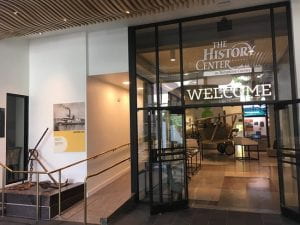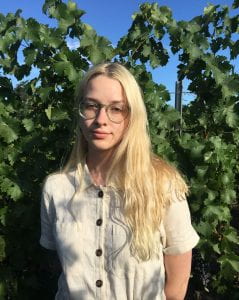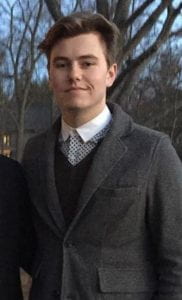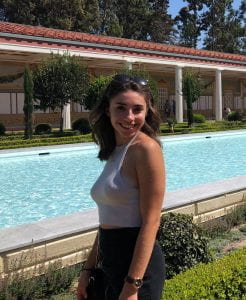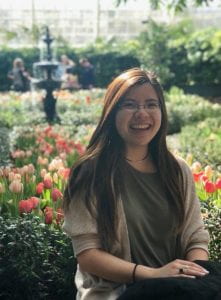Welcome to The History Center Team!
An Introduction to Our Work
This semester our team set out to conduct in depth research and analysis to discover ways in which local school systems could integrate Transmedia Knowledge into their curriculum through project based learning. To enable our goal, we aimed to enhance schools’ ability to utilize the many community institutions at their disposal. On numerous occasions we met with the THC Staff to learn and consult on how their resources could be utilized by schools to build in-depth, engaging learning programs that capitalize on the framework of Transmedia knowledge.
As the semester progressed and students were forced to relocate off-campus and begin online-instruction, our project focus shifted towards analyzing how our current research could be applied in the context of virtual learning. In the following sections, you will find a more in-depth depiction of our project timeline, in which we investigate how we can maintain our research goals amidst the current online-learning circumstances.
An Overview of the Semester’s Research & Analysis
Click here to be redirected to a complete report that documents the entirety of our team’s work throughout the semester.
- A museum exhibit space with various physical and virtual exhibits
- A gallery space for presenting community work and school projects from local artists, activists, students, and professionals
- And a vast historical archive that is home to various artifacts documenting the past 300 years of Tompkins County’s settlement.
In our two visits, we got to know the ins and outs of the History Center’s space, and were able to gather a deeper understanding of how we could design initiatives so that local schools would be able to utilize their resources. It wasn’t until our second visit where we were able to work hands on with Dryden High School students conducting research for projects creating hyper-focused documentaries that we were able to narrow down our focus and form a concrete plan for designing programs that would better serve schools’ abilities to capitalize on community partnerships with institutions like the history center.
Defining a Goal
We utilized our insight gathered in conducting our field visits to define a tangible method for achieving our goal of integrating transmedia knowledge into the education system via enhanced community partnerships. To aid in our thought development, we developed an info-comic, which allowed us to visually depict specific use-cases in which the History Center’s resources could be best utilized by the community, which allowed us to proceed with a more concrete goal in mind. Additionally, we each constructed PechaKucha’s (see bottom of page) that which were useful in guiding our thought process and helped us set our ultimate goal, to design programs for schools to implement which would allow them to utilize the History Center’s Resources in various learning scenarios allowing students to get outside the classroom and into the community, which could be easily be scaled by following the same methodology we outlined in detail in the full report.
Going Virtual
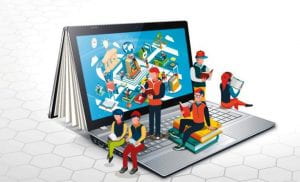
Just as our project began to take shape, the world was put on pause. Due to the unfortunate circumstances surrounding the spread of Coronavirus, we had to face the unfortunate reality that to continue with our work, we would need to shift our focus towards designing a solution that took into account the research we’d already collected, and applied it to a virtual learning space. It was here in which our project took a more holistic approach as the History Center, like most other institutions, was forced to close its exhibit space to the public resorting to a digital medium to share their resources with the community.
Virtual Design Proposals
Given our new virtual circumstances, we moved forward with two new proposals that maintained the focus of our original design goal of integrating transmedia knowledge into project based learning. Our design think was based on the idea of enabling schools to take history into their own hands. We curated a handful of resources and documented various production and publishing methods to allow schools to build projects in podcasting and creating virtual exhibits.
Podcasting: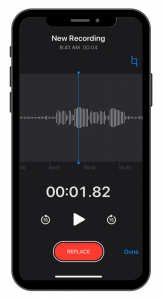
- podcasts are an easily digestible and popular way to learn and get takes on current affairs
- accessible, interesting, and consumable in a number of different scenarios
- low amount of production cost, no barriers to entry
Within the confines of our project goals, podcasts could be used as a method for students to:
- Document and reflect on their lives under quarantine
- interview their friends and family regarding pertinent issues
- Use THC resources and apply lessons in virtual learning assignments to document an oral history of the current climate
- Create artifacts of one of the most unprecedented times in human history!
Check out a great example of how to easily develop podcasts here!
Virtual Exhibits
- Use cutting edge technology, Artsteps to build interactive digital exhibits that allow users to engage with content from a distance
- Can be applied to a number of scenarios in both academic and pop-culture contexts
- Allow students, artists, and professionals to document their work in an easily accessible, completely customizable virtual environment free of spatial restrictions
Within the confines of our project, virtual exhibits could be for students to:
- Develop exhibits that show appreciation for the places they live
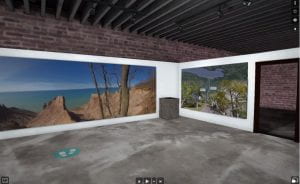
- Complete and showcase refocused virtual learning projects for any given class
- Use the CAT design frame to analyze, critique, and present on what makes
their personal landmarks special - Utilize THC resources to digitally document and share Tompkins’ County’s
historical archives and share their importance - Digitize museum life that’s been put on pause due to Covid-19!
Crash Course in Transmedia Knowledge Using PechaKuchas
To complement our extensive field report, our team created 4 instructional videos using the PechaKucha method to help viewers get a stronger visual understanding of the framework of our project as a whole. The 4 PechaKucha’s below cover 4 different integrations of Transmedia knowledge which investigate on the micro-level how the various themes play out in the context of The History Center. While they focus on aspects of Transmedia Knowledge that apply directly to our specific line of work, they serve as a foundation for applying various principles of Transmedia Knowledge outside of the scope of our project.
Through learning more about Pop-up Exhibits, the CAT Design Frame, Place-based Learning, and Digital Storytelling, we hope that you’ll be able to foster a better understanding of how various principles of Transmedia knowledge can be applied in a number of different contexts.
| Pop-up Exhibits | CAT Design Frame: The Ultimate Life Skill |
| Transmedia Knowledge and Place-based Learning | Digital Storytelling |
Deliverables
THC Team PechaKucha | The History Center * Originally presented live
THC Team Storyboard | Storyboard
Design Implementation Info-Comic | Info-Comic
Illustrated Research Report | Complete PDF Report
How to: Podcasting | Podcasts
Individual TK PechaKuchas
Marinna Chung | Pop-up Exhibits
Jeremy Dingle | Transmedia Knowledge in Place-based Learning
Lara Harvey | CAT Design Frame: The Ultimate Life Skill
Gwen Stark | Digital Storytelling

